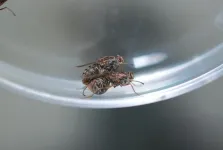(Press-News.org) Women with a short cervix around 20 weeks of pregnancy have an increased risk of preterm birth. Preventing preterm birth in pregnant women with a short cervix is a crucial step in protecting the health of the child. Research from Amsterdam UMC now shows that, in pregnant women with a short cervix around 20 weeks, Progesterone (a hormone) is better than a cervical pessary at reducing the risk of severe preterm birth. This study was published today in the BMJ.
"This is an important improvement that can contribute to the reduction of preterm births and the associated complications, such as an increased risk of infant mortality and long-term health problems for the child," says Eva Pajkrt, professor of obstetrics at Amsterdam UMC.
Preterm birth, defined as birth prior to 37 weeks, remains a serious problem with far-reaching consequences. Approximately 13.5 million children worldwide are born preterm each year. Children who are born preterm are at higher risk for, both physical and developmental, lifelong complications. Preventing preterm birth is therefore a major priority at the obstetrics department of Amsterdam UMC.
Reducing extreme preterm birth
The research team at Amsterdam UMC investigated the best treatment for women with a cervical length shorter than 25 mm at the 20-week ultrasound scan. In 25 centres across the Netherlands participated in this study. Women with a short cervix were eligible for randomization between progesterone and pessary. The results of this study show that Progesterone is more effective than a pessary in reducing extreme preterm birth. This study underlines the importance of measuring the length of the cervix during the 20-week ultrasound scan and informing women with a cervix shorter than 25 mm about the possibility of treatment with Progesterone.
No significant difference
For women with a cervical length between 25 mm and 35 mm, there was no significant difference in the number of complications due to preterm birth between the group taking Progesterone and the group using a pessary. "Based on our study, we recommend measuring the length of the cervix of all pregnant women during the 20-week ultrasound. Women with a cervix shorter than 25 mm should be informed about the possibility of treatment with Progesterone," says Pajkrt.
The results of this study are of great importance for the healthcare system and can contribute to the reduction of preterm births and the associated complications. With major consequences for both the individual and for our society,” Pajkrt concludes.
END
Progesterone protects babies from preterm birth
Amsterdam UMC led study shows that progesterone is better than a pessary at protecting women with short cervixes from preterm birth
2024-03-13
ELSE PRESS RELEASES FROM THIS DATE:
School-age girls with obesity are more likely to experience joint and muscle pain
2024-03-13
Girls with obesity are more likely to experience pain in their bones, joints, muscles, ligaments or tendons compared with children with a healthy weight, according to research by Queen Mary University of London. The same did not apply to boys.
Queen Mary researchers hope their findings will raise awareness that obesity may contribute to musculoskeletal problems in children.
In the study, published today in Archives of Disease in Childhood, researchers analysed anonymised information on 120,000 children, linking data from the National Child Measurement Programme with GP records. They found that girls with obesity were 1.7 times more likely than those ...
New analysis: most care homes closed by industry regulator are run for-profit
2024-03-13
A new analysis led by researchers at the University of Oxford and funded by the Nuffield Foundation has found that virtually all care homes forced to close in England by the Care Quality Commission are run on a for-profit basis. The results, published today in The Lancet Healthy Longevity, raise questions about the role of the private sector in exacerbating the care sector’s ongoing crisis.
The study assessed the number of care homes which had been forced to close by the independent regulator of health and social care in England, the Care Quality Commission ...
A simple intervention benefits cancer patients while saving hospitals money, Pitt study showed
2024-03-13
Cancer patients who received specialized mental health support as part of their treatment plan are more likely to see improvements in their quality of life and reductions in pain, depression and fatigue, according to a study led by researchers at the University of Pittsburgh School of Medicine.
In addition to lasting improvements in patients’ quality of life, researchers observed lower risk of cardiovascular disease in family caregivers, as well as substantial cost savings to the healthcare system. The findings from a Phase III clinical trial were published today in The Lancet.
“The ...
Major typhoid fever surveillance study in sub-Saharan Africa indicates need for the introduction of typhoid conjugate vaccines in endemic countries
2024-03-13
There is a high burden of typhoid fever in sub-Saharan African countries, according to a new study published today in The Lancet Global Health. This high burden combined with the threat of typhoid strains resistant to antibiotic treatment calls for stronger prevention strategies, including the use and implementation of typhoid conjugate vaccines (TCVs) in endemic settings along with improvements in access to safe water, sanitation, and hygiene.
The findings from this 4-year study, the Severe Typhoid ...
Rice’s Naomi Halas awarded Optica’s C.E.K. Mees Medal
2024-03-13
HOUSTON – (March 13, 2024) – Rice University’s Naomi Halas has been selected as the 2024 recipient of the C.E.K. Mees Medal by Optica for “her design, fabrication, and demonstration of nanoparticles with specific optical and physical properties, the widespread application of which enables advances in fields including cancer therapy, water security, and light-driven chemistry.”
Halas’ groundbreaking work in nanotechnology has enabled the creation of metal nanoparticles possessing structural ...
Giant sequoias are a rapidly growing feature of the UK landscape
2024-03-13
UCL Press Release
Under embargo until Wednesday 13 March 2024, 00:01 UK Time
Imported giant sequoia trees are well adapted to the UK, growing at rates close to their native ranges and capturing large amounts of carbon during their long lives, finds a new study led by UCL researchers with colleagues at the Royal Botanic Gardens, Kew.
The new research, published in Royal Society Open Science, found that the most massive species of redwood trees, Sequoiadendron giganteum, known as the giant sequoia, can potentially pull an average of 85 kilograms of carbon out ...
Who knew that eating poo was so vital for birds’ survival?
2024-03-13
We all know that the early bird gets the worm, but new research shows they turn to something far more nutritious for their breakfast.
Poo – either their own, or from other birds – provides them with essential nutrients, energy, and helps them adapt to new environments and seasonal variations, especially when they are developing.
New research led by the University of South Australia and published in Biological Reviews explains how eating faeces (known as coprophagy) shapes wild birds’ digestive tracts (gut biota), enabling them to absorb lost or deficient nutrients and adjust to seasonal variations in food sources.
This ...
Tsetse fly fertility damaged after just one heatwave, study finds
2024-03-13
The fertility of both female and male tsetse flies is affected by a single burst of hot weather, researchers at the University of Bristol and Stellenbosch University in South Africa have found.
The effects of a single heatwave were even felt in the offspring of heat exposed parents, with more daughters being born than sons.
The study, published today in Proceedings of the Royal Society B, helps explain why tsetse are declining in some parts of their range in Africa and has important implications for the disease they spread, particularly sleeping sickness in humans and nagana in cattle.
Lead author ...
New UAF lidar will add to space weather research capability
2024-03-12
University of Alaska Fairbanks scientists are developing a new light detection and ranging instrument to help gain a better understanding of space weather enveloping Earth.
The new laser radar, or lidar, will be the third for the UAF Geophysical Institute. It will measure temperature and neutrally charged iron in the upper atmosphere at altitudes of 75 to 125 miles, where the mesosphere and thermosphere meet.
Understanding the processes and influences at that altitude has become increasingly important as the proliferation of low-Earth orbit satellites continues and more nations send probes through ...
A simple and robust experimental process for protein engineering
2024-03-12
Image
A protein engineering method using simple, cost-effective experiments and machine learning models can predict which proteins will be effective for a given purpose, according to a new study by University of Michigan researchers.
The method has far-reaching potential to assemble proteins and peptides for applications from industry tools to therapeutics. For instance, this technique can help speed up the development of stabilized peptides for treating diseases in ways that current medicines can't, including improving how exclusively antibodies bind to their targets in immunotherapy.
"The rules that govern how proteins work, from sequence to structure to function, are ...
LAST 30 PRESS RELEASES:
Post-stroke injection protects the brain in preclinical study
Cardiovascular risk score predicts multiple eye diseases
Health: estimated one in ten British adults used or interested in GLP-1 medications for weight loss
Exercise to treat depression yields similar results to therapy
Whooping cough vaccination for pregnant women strengthens babies’ immune system
Dramatic decline in new cases of orphanhood in Uganda driven by HIV treatment and prevention programs
Stopping weight loss drugs linked to weight regain and reversal of heart health markers
Higher intake of food preservatives linked to increased cancer risk
Mass General Brigham–developed cholera vaccine completes phase 1 trial
First experimental validation of a “150-year-old chemical common sense” direct visualization of the molecular structural changes in the ultrafast anthracene [4+4] photocycloaddition reaction
Lack of support for people on weight loss drugs leaves them vulnerable to nutritional deficiencies, say experts
Dogs’ dinners can have greater climate impact than owners’
Are you ready to swap salmon for sprats and sardines?
1.6 million UK adults used weight loss drugs in past year
American College of Cardiology comments on new dietary guidelines for Americans
American Society of Gene & Cell Therapy and Orphan Therapeutics Accelerator partner to advance and commercialize promising rare disease treatments
One in 14 patients having day case surgery have new or worse chronic pain 3 months after their operation
New study highlights link between eviction rates and gun violence
Heatwaves heat up soil but not toxin levels in rice, study finds
Digital modeling reveals where construction carbon emissions really come from
Turning farm waste into water filters
New study shows how the spleen helps the immune system accept a transplant
New Mayo Clinic study advances personalized prostate cancer education with an EHR-integrated AI agent
Researchers identify novel therapeutic target to improve recovery after nerve injury
Microbes in breast milk help populate infant gut microbiomes
Reprogramming immunity to rewrite the story of Type 1 diabetes
New tool narrows the search for ideal material structures
Artificial saliva containing sugarcane protein helps protect the teeth of patients with head and neck cancer
Understanding the role of linear ubiquitination in T-tubule biogenesis
Researchers identify urban atmosphere as primary reservoir of microplastics
[Press-News.org] Progesterone protects babies from preterm birthAmsterdam UMC led study shows that progesterone is better than a pessary at protecting women with short cervixes from preterm birth




